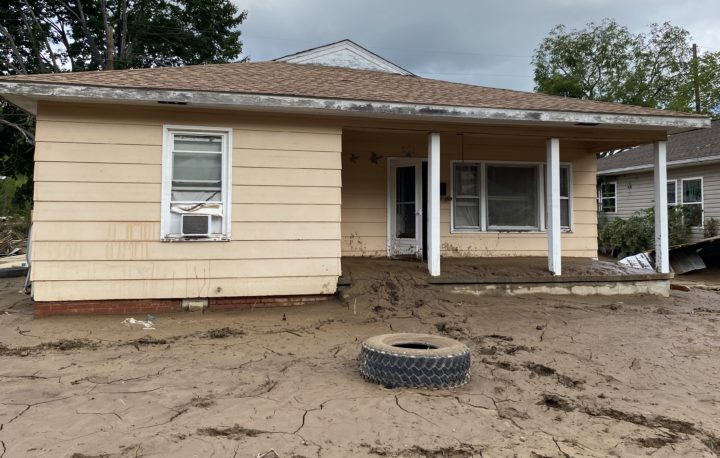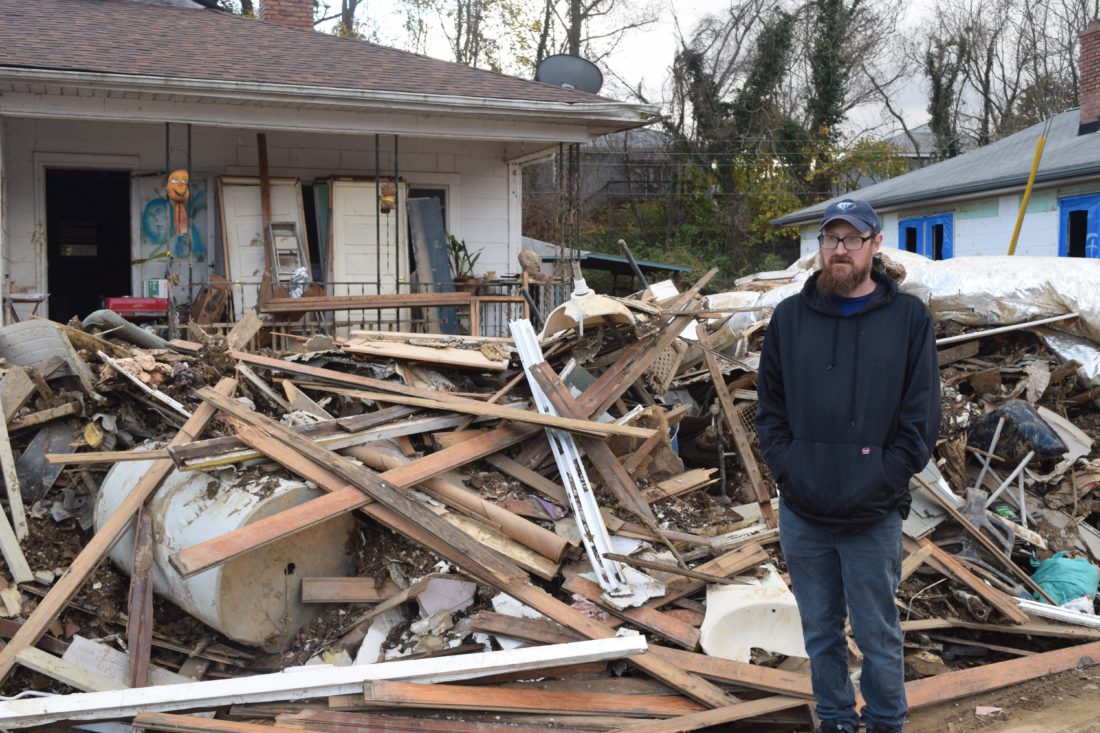A massive dehumidifier roars in Michael Burgin’s nearly 100-year-old home in Beacon Village. The house, stripped to the studs, is now dominated by its two fireplaces. A pile of debris, nearly as tall as the house itself, sits out front.
Burgin and his family were inside when waters from the Swannanoa River came crashing into his home during Tropical Storm Helene on Sept. 27.
“We started getting our pets and our valuables up high as early as we could. … We went up into the attic, and then it just kept rising and rising, and it became immediately clear that it was going to reach the attic,” Burgin says.
Out of places to climb, they had to swim through the kitchen and wedge through a first-floor window onto the roof. A couple of neighbors on higher ground came to the rescue, kayaking through the rapids with tools to help Burgin chop through the attic roof to save his dogs.

Once the water receded, and after a grueling mucking-out process, Burgin began the race against the mold — wrangling as many dehumidifiers and fans as he could into the home to lower the moisture.
Now that he has his building permit, Burgin has been learning how to keep the character of the historic home while shoring up its infrastructure. Most of the homes in his neighborhood were built in the 1920s.
“There’s a lot of things, especially up in the structure of the attic, that probably wouldn’t pass code today,” Burgin says.
Yet if it weren’t for the home’s old-school construction, Burgin believes the outcome would have been a whole lot worse. And it is an opinion that others share, he adds, noting the Samaritan’s Purse, an organization that offers disaster relief to individuals across the globe.
“They seemed pretty convinced that we probably would have floated away on the roof if this was a newer home,” Burgin says. “They think that the main reason so many of [the neighborhood homes] stayed on their [foundations] is because of the materials they were made out of back then.”
And it was this material, Burgin continues, that drew him to purchase the property in 2019.
“I really liked the hardwood floors, but they were obviously destroyed,” Burgin says. “I hated that we couldn’t save any of it, but it was already so moldy. It’s crazy how fast the mold comes.”
In the same neighborhood, Miah Reis is battling her own mold invasion.
“One big challenge is getting the joists and the studs dried out to the point where I can rebuild. These old houses have a lot of previous termite damage and a lot of moisture retention, and so it’s a struggle to try to keep these generators going all the time, incessantly, to dry them out,” Reis says. “If they’re not dried out, then they can’t rebuild, or they’re going to end up having to replace all of them.”
Reis’s great-grandparents purchased the home, built in 1925, directly from Beacon Manufacturing Co., which constructed Beacon Village in Swannanoa as housing for mill workers.
In a single day in September, the yard that was the backdrop for Reis’ fondest childhood memories, the living room that hosted countless holiday gatherings and the walls that had stood for nearly a century were engulfed by water.

“It was my great-grandparents, and then my grandparents lived in it for well over 60 years. My parents did live in it for a time, but they moved out on their own. But then I inherited it after my grandmother passed away,” says Reis of her historic home in Swannanoa, now stripped to the studs and joists. “I mean, this house, it was my oasis.”
All that was salvageable from the flood were a box of family photos — miraculously preserved in an airtight bin — a couple of vintage end tables and her grandmother’s antique cookie jars.
Reis’ home is a shell of its former self, but she plans to do everything she can to rebuild.
“When I first moved in … I decided that this was going to be my forever home,” Reis says.
Many residents are facing the daunting task of cleanup and repair post-Helene, but those with historic houses such as Reis and Burgin have an added layer: preserving the area’s past for the future.
Fortunately, the two neighbors are seeing some signs of hope, including recent grants from the Preservation Society of Asheville & Buncombe County. The nonprofit, established in 1976, works to conserve the region’s heritage and sense of place through preservation and promotion of the region’s historic resources.
Tallying the toll
A week after Helene roared through the area, volunteers and staff from the Preservation Society assessed the damage to historical structures.
“Our focus is specifically any structure that’s 50 years or older, built 1974 or before,” says Jessie Landl, executive director. “We were driving through communities more broadly, taking a look around and seeing where things were impacted.”
Volunteers teamed up to drive along waterways — navigating nearly impassable routes — to survey historic structures in Swannanoa and East Asheville before fanning out toward Black Mountain and Montreat.
“There were days when the staff was driving around where we were just quietly driving through communities and crying because these are places we all love and live in and had experiences in and have memories,” Landl says.
Damage was widespread from Biltmore Village to Beacon Village, leaving layers of muck amid mountains of debris.
“You have one block where everyone’s homes are intact and in perfectly good condition, and the next block over where everyone has been forced to move out because they’re not livable,” Landl says.
Most of the volunteers were doing windshield surveys while more experienced surveyors did walking tours of areas hit hardest.
“We tried to go in every direction and just get a lay of the land, to understand what areas hit hardest and then, surprisingly, what areas sort of seemed to escape the worst of the damage,” Landl says. “That gave us a better idea of where we might be able to focus our efforts.”
The society already had a grant program for restoration projects dating to 2019 with the goal of making preservation of historic properties more accessible to rural communities and areas less frequently surveyed.
“We wanted to give communities the opportunities to tell us what their preservation priorities were as opposed to us being out in the community setting the priorities,” Landl says.
Following the storm, the society rallied for more grant funds, doubling the budget of $50,000 for the fiscal year to $100,000 — which burned up in only two weeks. The Community Foundation of Western North Carolina then provided a $50,000 grant.
“To date, we’ve done $150,000 in grants specific to damage from this storm to 30 different projects, and those are businesses and individual homeowners,” Landl says.
Each grant recipient received $5,000 for projects that preserve the longevity of historic structures — covering new roofs or grading to divert water away from the buildings.
“A lot of these homes are down to bare studs because everything’s had to be stripped out of them. Those were easy to prioritize as those applications came in,” Landl says.
The team also delivered dehumidifiers and generators to homes as soon as they could, racing the clock to beat mold growth.
Guidelines for repairs
While private residences in Beacon Village don’t have rebuild requirements, fellow grant recipients, like the owner of the building at 7 All Souls Crescent in Biltmore Village, have to follow guidelines laid out by the Historic Resource Commission (HRC). The 12-member commission was created in 1979 to set design standards for historic areas and landmark structures in the City of Asheville and Buncombe County. The HRC has rebuilding standards in four historic districts: Biltmore Village, Albemarle Park, Montford and St. Dunstan’s.
Enter Michael Logan, owner of Logan Restoration and Contracting in Black Mountain. His piece of repairing 7 All Souls Crescent, built in 1895, is saving its vintage windows following HRC guidelines.
“Almost all the windows we work on are over 100 years old, and so just that is a pretty good testament to their durability,” Logan says. “They were back then made to be repaired, whereas now the replacement windows that you would get are truly just made to be thrown away and replaced once again.”

Guidelines are intended to maintain the character of the area — for instance, you can’t build a Wild-West-themed storefront in Biltmore Village. Owners are advised to use original materials when feasible and rebuild with original details, not altering the style, roof or finish, according to HRC materials.
“When you buy a historic home, you’re more of a steward for that property than you are the lord over it,” says Tara Granke, Logan’s wife and office manager for the business. “You can’t just do whatever you want because you’re just one person in this long … continuing history of people and families that have lived there.”
Logan has had his hands full since the storm repairing historic windows at his workshop. His business specializes in keeping old windows out of the landfill, adding weatherproofing and restoring them.
“We’re trying to take what’s there and make it better instead of tearing it down and making it new. That’s probably one of my favorite parts about this type of work is that we’re really on the sustainable side of the construction process,” Logan says.
Fortunately, Logan says he has been able to repair 20 windows, with several more in the process of being restored.
“We can make individual parts and pieces for these windows. So say, if the bottom piece was rotted out, we can replicate a piece and just replace that bottom piece,” Logan says, noting that if the window has been split into a lot of pieces, it would be beyond repair.
“If the mold gets too far, then rot starts,” Logan says, however he noted that the old wood is known to be very rot- and pest-resistant.
“It’s sad to lose the old wood of the windows. The wood can be replaced and repaired, but you can’t get that old-growth wood back that the old windows are built from. That’s why they’re so beautiful and sustainable, because that old-growth wood, that virgin wood from the forest here before they were all cut down, that’s where those windows have come from. And it’s just really dense and it’s really irreplaceable,” Granke says.




Before you comment
The comments section is here to provide a platform for civil dialogue on the issues we face together as a local community. Xpress is committed to offering this platform for all voices, but when the tone of the discussion gets nasty or strays off topic, we believe many people choose not to participate. Xpress editors are determined to moderate comments to ensure a constructive interchange is maintained. All comments judged not to be in keeping with the spirit of civil discourse will be removed and repeat violators will be banned. See here for our terms of service. Thank you for being part of this effort to promote respectful discussion.